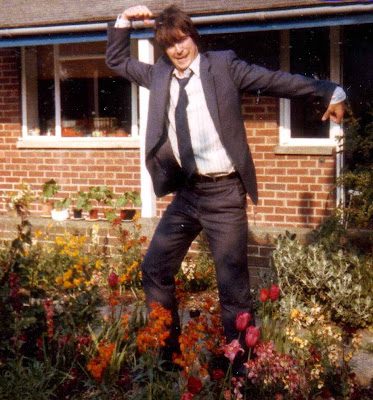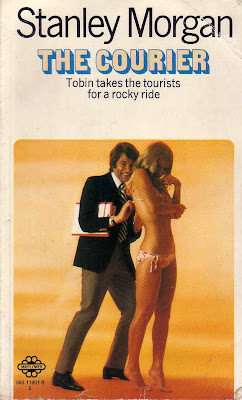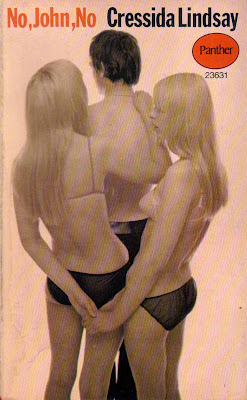






 But best of all, there is a little musical box at the end of the album. It doesn't really work, but every now and then, I can hear a faint twinkle from the other side of my office.
But best of all, there is a little musical box at the end of the album. It doesn't really work, but every now and then, I can hear a faint twinkle from the other side of my office.
It deepens like a coastal shelf







 But best of all, there is a little musical box at the end of the album. It doesn't really work, but every now and then, I can hear a faint twinkle from the other side of my office.
But best of all, there is a little musical box at the end of the album. It doesn't really work, but every now and then, I can hear a faint twinkle from the other side of my office.
 At some point in the late 1940s, she marries a man who shares her passion for dogs and they move here:
At some point in the late 1940s, she marries a man who shares her passion for dogs and they move here: This bungalow is typical of the poor quality, jerry-built housing that flourished in Britain until more rigorous planning legislation was introduced. Today it is next to some dog kennels. Perhaps the husband and wife were responsible for establishing their home and the kennels.
This bungalow is typical of the poor quality, jerry-built housing that flourished in Britain until more rigorous planning legislation was introduced. Today it is next to some dog kennels. Perhaps the husband and wife were responsible for establishing their home and the kennels.
 Indeed, over half of the the album consists of photos of dogs. But in between breeding dogs, the couple managed to find the time to have two children: a boy and a girl. Here is their young daughter in the late 1960s:
Indeed, over half of the the album consists of photos of dogs. But in between breeding dogs, the couple managed to find the time to have two children: a boy and a girl. Here is their young daughter in the late 1960s: And here is their son:
And here is their son:
 There is no discernible chronology to the album. Events in the daughter's life - graduation, marriage and the birth of a child - are presented in a random order and both children are eclipsed by the numerous photos from dog shows:
There is no discernible chronology to the album. Events in the daughter's life - graduation, marriage and the birth of a child - are presented in a random order and both children are eclipsed by the numerous photos from dog shows: The woman and her husband must have been well-known figures in the dog breeding world and many of the photos are official portraits from shows, where they had won first prize.
The woman and her husband must have been well-known figures in the dog breeding world and many of the photos are official portraits from shows, where they had won first prize. On the same page, there is a photograph of a gravestone. It is their son's.
On the same page, there is a photograph of a gravestone. It is their son's. I had been complacently flicking through the album, enjoying the 1960s fashions and scenes from dog shows. Nothing prepared me for the shock of the final page.
I had been complacently flicking through the album, enjoying the 1960s fashions and scenes from dog shows. Nothing prepared me for the shock of the final page. In my day, these people were called students. In the Professor's time, louche characters like this were beyond his help, as were these sorry specimens from the underclass:
In my day, these people were called students. In the Professor's time, louche characters like this were beyond his help, as were these sorry specimens from the underclass: However, Professor Wells was able to offer treatment to paying gentlemen like these:
However, Professor Wells was able to offer treatment to paying gentlemen like these:


 The cathedral is beautiful by any standards, but what makes it particularly stunning is its successful blending of the ancient and modern, thanks to the extraordinary vision of George Bell and Walter Hussey.
The cathedral is beautiful by any standards, but what makes it particularly stunning is its successful blending of the ancient and modern, thanks to the extraordinary vision of George Bell and Walter Hussey. I love the way that medieval tombs sit alongside bold, Cubist-inspired tapestries. I know that these contemporary works of art ruffled a few feathers when they were installed, but nearly 50 years on, they seem perfectly at home. Bishop Bell's vision has ensured that the Cathedral is a living church rather than a museum piece.
I love the way that medieval tombs sit alongside bold, Cubist-inspired tapestries. I know that these contemporary works of art ruffled a few feathers when they were installed, but nearly 50 years on, they seem perfectly at home. Bishop Bell's vision has ensured that the Cathedral is a living church rather than a museum piece. When I returned to work, I tried to convey the excitement of Chichester Cathedral. "They've got a Marc Chagall window!"
When I returned to work, I tried to convey the excitement of Chichester Cathedral. "They've got a Marc Chagall window!" The medieval Arundel Tomb is remarkable. I have written about it before here, three years ago and quoted the full Philip Larkin poem, with its beautiful last line, "What will survive of us is love".
The medieval Arundel Tomb is remarkable. I have written about it before here, three years ago and quoted the full Philip Larkin poem, with its beautiful last line, "What will survive of us is love". But I wouldn't want to live there. Perhaps that's because I associate the place with Waterstone's.
But I wouldn't want to live there. Perhaps that's because I associate the place with Waterstone's. Never mind those literary novels written by bespectacled milksops. We want our books to be vigorous and virile, with lots of weapons, heaving bosoms and double-crossing foreigners.
Never mind those literary novels written by bespectacled milksops. We want our books to be vigorous and virile, with lots of weapons, heaving bosoms and double-crossing foreigners. If I had a pound for every time a broadsheet hailed a band as the next big thing, I'd be able to afford a weekend for two at a Best Western hotel in a provincial city. Off season.
If I had a pound for every time a broadsheet hailed a band as the next big thing, I'd be able to afford a weekend for two at a Best Western hotel in a provincial city. Off season. The following images are of a random selection of things that have appeared in deliveries like the one above, during the last few days. None of them are worth a penny, but to me they are priceless:
The following images are of a random selection of things that have appeared in deliveries like the one above, during the last few days. None of them are worth a penny, but to me they are priceless: Until yesterday, I was blissfuly unaware of the existence of "The Girl From U.N.C.L.E", Look! It's Stephanie Powers and Noel "Windmills of Your Mind" Harrison. The fashions are very "Girls who are boys, Who like boys to be girls, Who do boys like they're girls..." I'm not sure about the hat.
Until yesterday, I was blissfuly unaware of the existence of "The Girl From U.N.C.L.E", Look! It's Stephanie Powers and Noel "Windmills of Your Mind" Harrison. The fashions are very "Girls who are boys, Who like boys to be girls, Who do boys like they're girls..." I'm not sure about the hat. My address book desperately needs a Knight of the Realm in it, but sadly Sir Hugh is no longer with us. A quick search on Google reveals that his neighbour's house recently sold for £6,000,000.
My address book desperately needs a Knight of the Realm in it, but sadly Sir Hugh is no longer with us. A quick search on Google reveals that his neighbour's house recently sold for £6,000,000. This mysterious photograph has no name or date, but if I had to guess, I would say that it's London in the 1920s-30s. The way the photographer has almost completely cut out one of the subjects reminds me of my mother, who once managed to take an entire film of her left eye.
This mysterious photograph has no name or date, but if I had to guess, I would say that it's London in the 1920s-30s. The way the photographer has almost completely cut out one of the subjects reminds me of my mother, who once managed to take an entire film of her left eye. Spot the ball, from the good old days, when men's trousers came right up to the diaphragm.
Spot the ball, from the good old days, when men's trousers came right up to the diaphragm. "Josephine and Cherry were the first out of the water", from "It Turned Out Fine", by M. E. Host. Not one of the most compelling book titles I've come across. I'd gladly read a book called "The Approaching Tempest" or "The Angry Sea", but "It Turned Out Fine" conveys all the drama and excitement of a weekend in Torbay.
"Josephine and Cherry were the first out of the water", from "It Turned Out Fine", by M. E. Host. Not one of the most compelling book titles I've come across. I'd gladly read a book called "The Approaching Tempest" or "The Angry Sea", but "It Turned Out Fine" conveys all the drama and excitement of a weekend in Torbay. This enigmatic, Classical nude that looks rather out of place in this setting. As usual, there was no information about the photo and there wasn't even a tenuous link between the book and the image.
This enigmatic, Classical nude that looks rather out of place in this setting. As usual, there was no information about the photo and there wasn't even a tenuous link between the book and the image. What was it with the 1960s? I blame it all on the Skiffle bands.
What was it with the 1960s? I blame it all on the Skiffle bands.
 In my early teens, I went to stay in a cottage in Somerset that was full of books like these. I sneaked a few into my room and almost trembled with anticipation at the forbidden fruits that lay ahead.
In my early teens, I went to stay in a cottage in Somerset that was full of books like these. I sneaked a few into my room and almost trembled with anticipation at the forbidden fruits that lay ahead. I've often thought how strange blogging is. We have interesting, meaningful exchanges with complete strangers on the internet, but there is never any question of meeting in real life.
I've often thought how strange blogging is. We have interesting, meaningful exchanges with complete strangers on the internet, but there is never any question of meeting in real life.


 "Herr Hitler, instead of just waving at people, have you ever thought of trying a special salute like this?"
"Herr Hitler, instead of just waving at people, have you ever thought of trying a special salute like this?" Adolf Hitler is an important historical document and if you want to know how a nation came to fall under the spell of a mass psychosis, it is important to read contemporary source material like this. Of course there will be people out there who are attracted to material of this kind for the wrong reasons, but that doesn't justify banning books.
Adolf Hitler is an important historical document and if you want to know how a nation came to fall under the spell of a mass psychosis, it is important to read contemporary source material like this. Of course there will be people out there who are attracted to material of this kind for the wrong reasons, but that doesn't justify banning books.